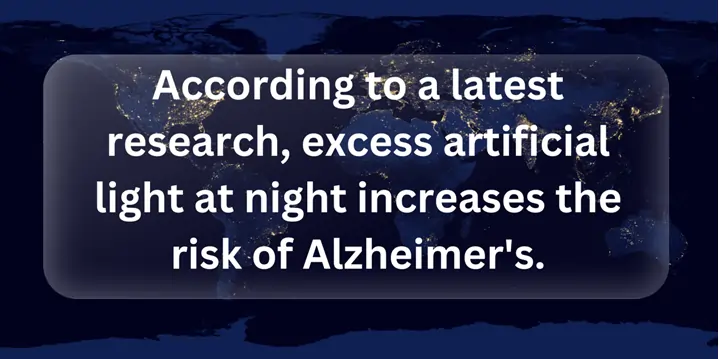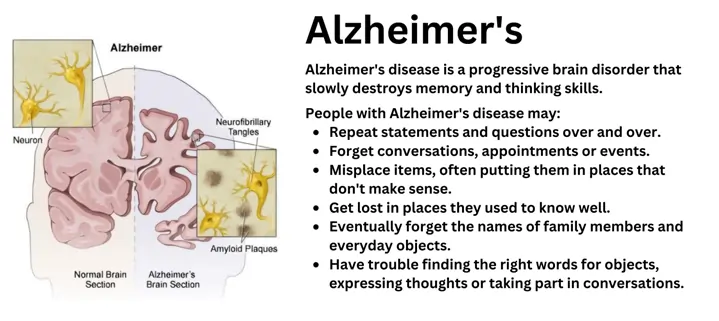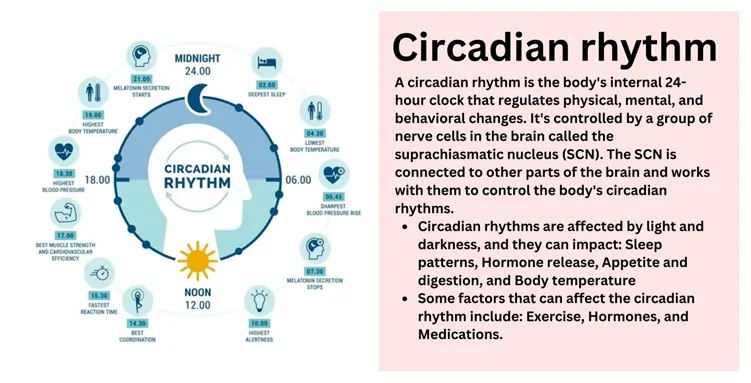According to a latest research, excess of artificial light at night increases the risk of Alzheimer's. Researchers in the US have reported that 'there is a correlation between light pollution caused by artificial light at night and Alzheimer's disease.'

Highlights of the research
- Robin Voigt, Bichun Ouyang, and Ali Keshavarzian, researchers at Rush University Medical Centre in Chicago, reported in a report published in Frontiers in Neuroscience on September 6 that "exposure to artificial light at night increases the risk of Alzheimer's and has been identified as an environmental factor of Alzheimer's."
- According to earlier research, many factors can be responsible for the development of Alzheimer's, such as genetics, medical conditions and environmental stress. New research has added a new environmental factor, light pollution, to this, which was not known earlier.
- Satellite-derived light pollution data was used for the study, and it was combined with publicly available Medicare data reports based on the prevalence of Alzheimer's. Other medical data, which is known or potential risk Factors related to Alzheimer's were also included in the analysis.
- The researchers found that medical conditions such as diabetes and high blood pressure were greater risk factors for the prevalence of Alzheimer's than light pollution, but light pollution in general was a greater risk factor than factors such as alcohol abuse, chronic kidney disease, depression, heart failure, and obesity.
- According to Robin Voigt, one of the researchers, exposure to light at night disrupts the natural circadian rhythm and affects sleep, making a person more susceptible to the disease. In addition, "disruption of circadian rhythm increases the likelihood of having or developing diseases that are greater risk factors for Alzheimer's, including obesity, diabetes, and depression."
- About 80% of the world's population is exposed to light pollution. Although artificial night-time light is often considered harmless and sometimes even beneficial (such as for safety), this study highlights the many negative effects of light pollution on both humans and the environment. This research makes an important contribution to the growing concern about light pollution and raises an issue that policymakers should pay attention to, but currently do not.
What is Alzheimer's?

- Alzheimer's disease is a kind of dementia, an umbrella term encompassing a number of disorders associated with loss of cognitive function, comprising the slow, cumulative deterioration in mental functioning, including memory, reasoning, judgment, and learning capacity.
- Alzheimer's disease causes accumulation of beta-amyloid (an abnormal, insoluble protein) in brain tissue. Clusters of dead nerve cells forms around the nucleus region of the beta-amyloid, called neuritic (senile) plaques.
- There is an increase in the levels of tau, an abnormal protein that is a component of neurofibrillary tangles and beta-amyloid.
- In addition, some neurons, which are involved in storing and processing memory, age more rapidly.
- All people develop these abnormalities to some degree with aging, but they are more pronounced in Alzheimer's patients.
- Forgetfulness is one of the earliest symptoms of Alzheimer's, and as the disease progresses, patients become more confused, lose track of familiar places, and have difficulty planning and completing even simple tasks.
- According to a 2023 estimate by the World Health Organization (WHO), more than 55 million people worldwide suffer from dementia, of which about 75% suffer from Alzheimer's.
- India is believed to have 3 to 9 million people suffering from this disease, and this number will increase as India's population ages. The latest drugs can slow cognitive decline, but there is no cure available yet.
What is Natural Circadian Rhythm?

Natural circadian rhythm refers to the physical, mental and behavioural changes produced by the effects of light and darkness, which an organism experiences in a 24-hour cycle of day and night. In humans, almost every tissue and organ has its own circadian rhythm, and collectively they are driven to function according to the daily cycle of day and night. Circadian rhythms influence vital functions in the human body such as sleep patterns, hormone release, hunger and digestion, and body temperature.Our bodies are like complex musical compositions, performing delicate staves guided by an internal conductor – the circadian rhythm. Derived from the former Latin words circa (around) and diem (day), this rhythmic dance involves managing our sleep-wake schedules, hormone secretion, body temperature, and even feeling. It is why you notice you are more awake during the day and want to burrow under the covers at night. Some of the factors involved in it are:
- The Sunlit Baton: The core of our biological clock is the SCN (suprachiasmatic nucleus).The SCN always depends on information obtained from the external environment, particularly the sun. When sunlight hits our retinas, it signals the SCN: “Hey, it’s daytime!”As a result, the SCN conducts precise alterations to the signals that control the secretion of hormones and maintain the body’s circadian rhythm.
- Melatonin, Hormone: And, at night, the SCN draws the curtain for any further activity related to day time.Melatonin, the sleep-inducing hormone that puts us to sleep. Its levels increase in the evening and reach the maximum at night, between 2 and 4 in the morning.Blind people, who have no perception of light, still have circadian rhythms; ergo, our interior conductor does not rely solely on the visual system.
- Blue Light and Digital Sunsets: We have lost our pulse to the rhythm of life. Screens produce blue light all the time hence affect SCN. Dimming screens before bedtime may be useful. It’s high time it’s a digital sunset – your internal conductor will really appreciate it!
- Circadian Rhythms Beyond Sleep: Have you ever paid attention to the fact that some of the best workouts are achieved at certain times.It helps in digestion, strengthens the immune system and even the cognitive functions of the body and all this under the leadership of this conductor who is nowhere to be seen.
Light Pollution: When Our Nights Lose Their Darkness
Light pollution is defined as the artificial alteration of the intensity of outdoor light from its state as it existed naturally before Human interference. Imagine a silent night sky properly the one that has inspired poets, dreamers, and stars gazers from time immemorial. Imagine the said sky but with a hazy light that looks as if a constellation fell and pollutes an urban landscape. And that is what is known as light pollution.
Here are the key aspects of Luminous Phenomenon:
Sky Glow: Have you ever realized that cities are always alive? Lighting from cars, lampposts, commercial buildings, and structures change night time to day for the city dwellers. Sky glow means lit up night sky which works as celestial ceiling that impedes the observation of stars. Those who look for darkness in order to analyse the space, such as astronomers, face difficulties with their telescopes because of this light. Indeed, most of the people in the world have no access to stars and sky light which is usually obscured either by natural or artificial light in cities.
Health Impacts: Street lights are not just sources of artificial illumination, but also disrupters of circadian rhythms. Street lights are not in harmony with the circadian rhythm which is a twenty-four hour cycle in the physiological processes of the body that controls sleeping and waking. Too much exposureto light at night disturbs sleep, not only in persons, but also in animals and those that are abounding near it.
Wildlife and Ecosystems: To point out, light pollution doesn’tdiscriminate and will damage everyone. They harm commensal species like migrating birds, sea turtles, pollinators, etc. Avian species that relies on celestial bodies to guide them can get disoriented by light of buildings consequently resulting in mass ‘’catastrophic crashes.’’ Hatchlings of sea turtles are reported to be guided to the nearest artificial light source rather than the sea in the night lit by the moon. Fireflies — they need it to find their partners and anything that is too bright will interfere with their Mating. Therefore, the issue is not restricted to the beautifying of the night at the cost of natural aesthetics, but rather a case of changing ecosystems and natural behaviours.
Types of Light Pollution:
- Sky-glow: Such a scenario occurs when light pollution from cities and towns floods the night environment making it nearly impossible to distinguish the stars and other objects in the sky. Sky-glow is light which has reflected off objects in the stratosphere.
- Glare: Glare means when bright lights cause some discomfort or even reduce the amount of light that is required to see an object or surface. Some examples are the lights on the car, the street lamps or any light that blinks directly onto our eyes or any volt that blinds us while driving.
- Clutter: Clutter is best described as the presence of too many lights within a confined space. Ponder on bill boards, signs,neon lights and all forms of advertising competing for attention in cityscapes.
- Light Trespass: In the case where unwanted artificial lighting shines on areas which they are not intended over a property or area, it is referred as light trespass. For instance, if your neighbour’s floodlights are beaming light in your bedroom at night it is light trespass.
- Colour Temperature Shift: It is also important which colour of artificial light is used. It was also concluded that high-intensity blue–white LED lights, which have been increasingly used in public spaces over recent years and in the near future will be used even more, due to energy conservation, interfere with natural circadian rhythms in the ecosystems and affect the behaviour of animals and birds.
What can we do? Well, there is a movement around the world to reduce light pollution. It comprises usage of more weather-resistant luminaires, situating the down-lighting lights away from upwards, and boosting public knowledge on the use of dark skies. Probably, it is about time all of us do our modest part—turn the lights off a little and let the night creatures have their way.Light pollution is on the rise but response measures are achievable in the following ways:
- Shielded Lighting Fixtures: In regard to outdoor lighting, it is most appropriate to use fixtures that are bushed and that direct light in a downward direction. This eliminates unnecessary up-lighting and guarantees that the lighting is purposeful without being wasteful or shining up to the sky.
- Motion Sensors and Timers: You might also want to place the exterior lights on motion sensors or timers. These smart features make lights turn on only when they are required – when someone comes to the door of the house or passes through the garden.
- LED Light-bulbs: They are more energy efficient and emit directed light which is good for specific target locations. Changing to LED bulbs means that you are able to save both the energy and also minimize light pollution. Besides, they can work for several months or years and you will not need to climb a ladder to swap bulbs.
- Indoor Light Awareness: Switch off all indoor lights that can be avoided. Often they keep the lights turned on following the routines and at the same time, a little awareness can work wonders.
- Warm-Colour Bulbs: If you are installing outdoor lighting, then be sure to use bulbs that tend towards the warm end of the colour spectrum. These sources have softer more natural light and are not disturbing the night’s active animals and insects.
- Educate and Advocate: Spread awareness, Educate people around you, your community, and the local authorities about the impacts of excessive lighting at night. Promote responsible lighting practices and support reasonable outdoor lighting policies.